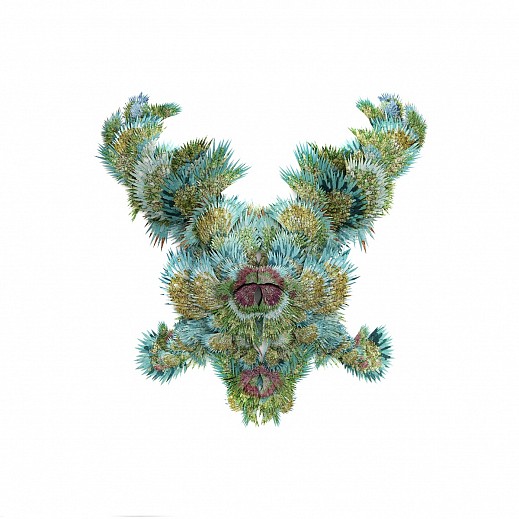
Invisible, Intangible, Insensible: Barbara Wildenboer's 'The Invisible Gardener'
June 8, 2017
Barbara Wildenboer’s second exhibition with Everard Read/CIRCA Cape Town, is dedicated to the invisible hand that guides nature, and the human hand that attempts to interpret it. At its heart, The Invisible Gardener is also a celebration of collage at luxurious scales. A microscopic image is scaled upwards, downwards and reintroduced into a variety of media whilst exploring a number of subject matters. Collages are photographed, cut up and collaged again, re-absorbed into Wildenboer’s visual language.

Barbara Wildenboer Residue and Excess I, 2017. Rephotography and handcut analogue collage
Waste and abundance form the core components of the series Residue and Excess I-VI (2017). Pages from crumpled magazines and newspapers are photographed and meticulously placed amongst images of antlers, octopi tentacles, and cameras from advertisements. From a distance, their individual features are somewhat difficult to discern. Housed in circular frames, the works are presented as contained moments of chaos.
However, like the work itself, the environment of The Invisible Gardener is pristine. CIRCA Cape Town is laden with a heavy air of ‘Old World charm’, created by the building itself, and the gallery’s proximity to the V&A Waterfront, and its port. The work seems appropriately situated near an active port, and the atmosphere of ‘exploration’, with its connotations of scientific discovery. Such endeavors into the scientific realm have occupied generations of artists, notably Michaelis academic Fritha Langerman and abroad, Mark Dion. Wildenboer dips into these disciplines and employs their visual references for her own use, making distinct references to visual scientific aids used to ‘exhibit’ biological or psychological phenomena.
In her series Recapitulation Theory (2016) maps are transformed into wings and foliage, each feather cut from paper in bright blue and green hues. The wings fan out and overlap one another, creating a new kind of organism. Their symmetry brings to mind the famous Rorschach Test, with its undefined, yet familiar forms. Narcissus I (2017) features the forms of individual snowflakes printed on glass, evoking the x-ray, or the cyanotype. The frames for the series are hexagonal, and interlock like honeycomb, referencing both the naturally occurring formation, and the basic visual representation of molecular structures. The snowflakes reappear in a film Grander Scheme, in which the snowflakes revolve and collide with each other.

Barbara Wildenboer Tower of Babel I, 2017. Rephotography and handcut analogue collage
The circle is repeated at careful intervals throughout the exhibition, coming to full effect in Theodicy (2017), evoking the forms of the microscope and the petri dish. Many of Wildenboer’s works form relations to the artifact behind glass. Theodicy refers to God’s ‘permission of evil’ within the universe in Christian doctrine. An installation mounted on the wall, the work comprises approximately 24 circular works, and an altar-esque relic with a thorn in a vase encased behind glass. This altarpiece forms the crux of the composition, bringing to mind something found in a holy place. Galaxies and biological matter share circular framing, drawing correlations between micro and macro scales of life.
The series Tower of Babel feature three tall, elegant fusions of photographic images and colour illustrations, and the works follow a narrative that could be read from top to bottom, or vice versa. A series of apocalyptic, regenerative scenes, the mushroom cloud of a bomb gives rise to a crocodile, and the moon, the ancient tower and the skyscraper. A bed of wild mushrooms forms the foot of Tower of Babel II, and in III the octopus seen in Residue and Excess re-emerges, this time clutching pearls. These associations are equal parts random and highly calculated – in essence, the summation of collage practice as we know it.
Anima Animus (2017) depicts two pelvic bones belonging to a female-bodied and a male-bodied person. Placed side-by-side, the bones are augmented by moving images overlaid onto their surfaces. A fluttering sphere, seen in Human Nature, is positioned centrally within each bone, toying with ideas of genitalia and arousal. The works’ title adopts Jungian archetypes of the feminine and the masculine, two essentialised concepts that are highly contested in our current discourse. Anima Animus reminds us that we, too, are biological beings. However, ideas of gender have transcended – and as some would argue – have never been contained within confines of the biological.

Barbara Wildenboer Theodicy, 2017. Printed Glass and Found Objects
Humans’ worrisome relationship to the earth is made more interesting when considering the invisible hand of a higher power. Wildenboer offers this suggestion undogmatically, making space for a number of alternatives, and perhaps more importantly, questions. In the extract from‘Theology and falsification: the University discussion’ by Antony Flew published in 1964, provided by the gallery, the presence of a mysterious ‘gardener’ clearly forms the basis for the title of the exhibition.
Compelling still, is to consider the unmistakable hand and labour of the artist herself. In all, the exhibition comprises moments of intense richness that give way to quiet, dream-like reflections. Wildenboer does not exhaust any subject, and within this allowance creates space for wonder. In the production of the exhibition, and her self-curation, her presence forms an additional omnipotent lens, in which she is the gardener of this ecosystem.
Back to News



